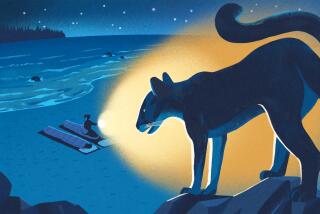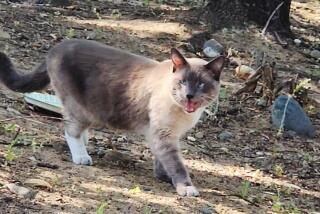Too Much Leopard
I was sitting with my husband, Robert Tragesser--a 6-foot, 4-inch logician--in a waiting room on Ventura Boulevard in Sherman Oaks. With us were Max MacElroy DVM, his assistant Lynne Perry and Cinder, a 6-month-old leopard who was leaping for Robertâs back. Robert was trying--and failing--to figure out what was happening to him. (Exactly how logicians end up in such enviable situations is a trade secret.)
I knew what was happening to him: Cinder is, like any kitty cat, intensely interested in people, and especially interested in figuring out which person in a room is the most interesting one to unsettle. Robert qualified because heâs tall (leopards love trees and are alert to height). It was also the first time he had found himself in the presence of a young, energetic and intelligent leopard, so he was sending out incongruent signals that made Cinder curious. You know about cats and curiosity. The old saying has it wrong, though. It is usually the mouse that is killed by the catâs curiosity, not the cat, and even if a mouse is a logician, satisfaction of the catâs curiosity doesnât bring the victim back.
Robert wasnât killed, but he did lose his heart to Cinder. This sort of thing happens with leopards, which is how MacElroy came to have big cats. The first one he had was Rocky, a lion, brought to him about 25 years ago at the age of 8 weeks with virtually every bone in his body broken. These were fractures caused by rickets. There was a bobcat with a similar story. Cinderâs mother had such a story. MacElroy fixes them up instead of putting them down, and thatâs how they become his pets.
Itâs because Cinder is properly handled that she didnât eat up Robert. An enormous amount of attentiveness is required in order to end up with a mentally and physically healthy and safe leopard in captivity. MacElroy and Perry have the rare capacity for this attentiveness.
Leopards, according to Bob Wagner at the American Assn. of Zoological Parks and Aquariums in Wheeling, W.Va., are thought of as the most cunning of the big cats. They are unlike lions, for example, in that they spend a lot of time in trees, and can even carry their kills--up to 45 pounds, about half their own size--into treetops and consume their dinners in the branches. Cunning , of course, is the sort of term you use if you are a zookeeper worried about keeping your skin whole. I must admit that I had the feeling that, at a minimum, there were two or three leopards in the room, and when Cinderâs brother was brought out, it seemed like a herd of leopards. Too much leopard.
While her paws express Cinder the mischievous kitten playing innocently, and her eyes and mouth reveal an affectionate kitty cat, the whole leopard reveals something else. The affectionate kitten is real, the mischievous kitten is real--and so is the leopard.
Who, as I said, didnât eat the logician on that day. But she terrified him. âI wasnât scared,â he said later. âBut it is hard to explain. I was terrified, not scared. She was uncanny--one moment landing as light as thistledown on my shoulder, and the next moment making herself weigh 600 pounds, or thatâs what it felt like.â
The usual fate of a captive leopard is a small cage or a zoo, when it isnât rickets and early death. Cinderâs fate, thanks to MacElroy and Perry, is not so bleak. In fact, she is slated to be a working cat, an actress, so you may see her on movie and television screens. She will, perhaps, play the part of a lovable pet, and you may be moved to want a leopard. Donât do that. Leave the big cats alone.
If you arenât bothered by the idea of the unhappiness a captive leopard usually suffers, then look at the extraordinary intelligence in Cinderâs eyes, and at how dangerously that intelligence flames there. Think of the thinness of your own skin.
Think, if you will, of the vanity involved in presuming that you could ever own or control what goes on behind those eyes.
More to Read
Sign up for Essential California
The most important California stories and recommendations in your inbox every morning.
You may occasionally receive promotional content from the Los Angeles Times.










